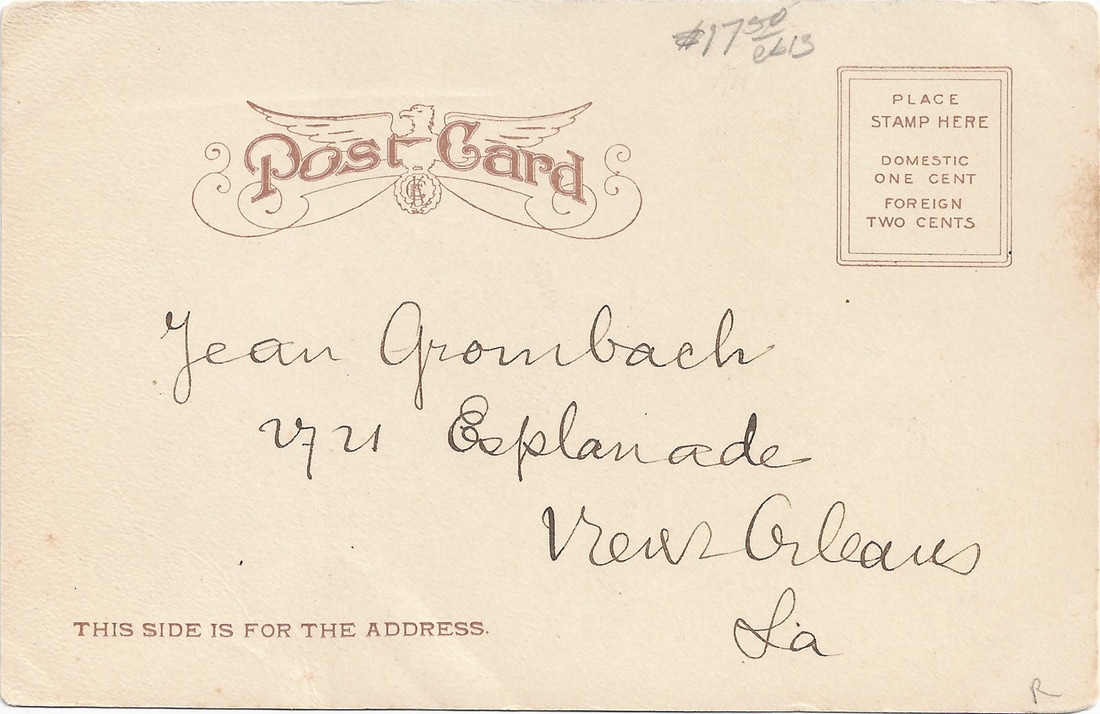Cotton Barge - Grombach
|
4-13-1906: View taken from the south bank of Buffalo Bayou toward the Union Compress Wharf on the north shore between the steel drawbridge which one day would be replaced with the McKee Street Bridge and the rail bridge for the Galveston, Harrisburg & San Antonio Rail Road (Southern Pacific) that served the compress warehouses.
|
4-10-2017: James Bute Park is situated where historic Frost Town from the 1830’s once lay. The park was named for James “Jim” Bute IV, champion of the McKee Street Bridge Habitat, and his grandfather James Bute I, an important businessman in the late 19tth and early 20th century. Now largely occupied by the homeless who survive under the bridges for I-69 over-girding the area, the banks of the bayou are overgrown with brambles, willows and small oaks. There are plans to create bike and hike trails like those on the north shore to bring in recreational users.
|
|
Postmarked: 1906-4-13
Not posted, perhaps enclosed within a letter Stamp: [none] To: Jean Grombach 2721 Esplanade New Orleans La From: [Andres Grombach, Jean’s father] Message: Sois bien gentil ance ta mamman Se tu vena que Le continue a l’curoyer descartes postales Avrel 13 1906 ------------------Translation from the French by Suzanne Manns--------------------- Be good to your mother if you want me to continue to send postal cards |
Jean Valentin Grombach was born January 2, 1901 in New Orleans, LA. He was the son of André Grombach of Macon, France and Marcella Valentin from Paris, France of Danish and French heritage. André worked in the dry goods import business, primarily between Mexico City, Tampico, San Salvador, Cuba and New Orleans. Grombach, Faisans Co., Ltd. traded “Mexican drawn work,” including a number of postcards of New Orleans and Dallas, San Antonio, and Brownsville, TX. His small family travelled back and forth to Paris, living there 1905-1907 and 1912-1913, maintaining a dual American-French residency.
Jean was carefully schooled in New Orleans, then attended West Point until 1923, where he went by the nickname “Frenchy” alias “Rudolph Vasellino.” He failed to graduate with his class due to excessive demerits, but with his father’s influence sorted this out and was eventually commissioned. He was a boxer on the 1924 Olympic team in Paris and later as an Olympic administrator. Jean married Margaret Louise Metzler on March 21, 1927 in Manhattan. Margaret was born October 19, 1908 in Lexington Ky. John Grombach spent five years as an MP, then served in the National Guard. When the war started in 1941 he was inducted back into service as a captain. The War Department needed a secure covert intelligence service and from the start G-2 - “The Pond”as the few-in-the-know professionals called it - was firmly under the control of John V. Grombach. As head of the Secret Intelligence branch of the War Department, he operated behind the scenes in the highest echelons of power. Most of his cover work was “Top Secret” and remained so for decades. After the war the agency was absorbed into the newly constituted CIA, with Grombach at the head. Firmly anti-communist, he covertly provided intelligence to Senator Joe McCarthy in his efforts to rid the government of communist infiltration. These behind-the-scenes activities widened a rift with Allen Dulles, the first titular head of the agency, and in 1955 Grombach was severed from the CIA. He became an international business consultant and private investigator, and served on the U. S. Olympic Games committees for the 1956, 1960, 1964, and 1968 Games and wrote a widely circulated Olympic Guide. John V. Grombach also published a number of books, including: Great Liquidator (1980) about Dr. Marcel Petiot, a surgeon Jean encountered in France during the war who murdered, then dissected and incinerated over 150 people, mostly Jews, for their hidden escape funds and life insurance policies. A recognized athlete, he published Touch Football (1942) and Saga of Sock: A complete story of boxing (1949). He died 1982 July 29 at Newton, Sussex County, NJ and is buried at West Point as “Brigadier General John V. ‘Frenchy’ Grombach.” |

